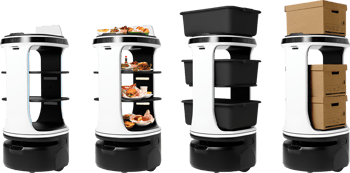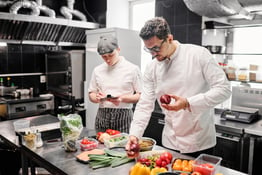The last several years have been challenging for restaurant operators, to say the least. Even as the COVID-19 crisis subsided, restaurants have struggled with high staff turnover, worker shortages, shrinking profit margins, and rising costs. Could robotics in food service be the key to confronting these challenges?
A growing number of restaurants are betting on it. From the automation of repetitive tasks to the dramatic acceleration of food production, the potential benefits of robots in restaurants are considerable.
Food service robots could offer the potential for improved efficiency, accuracy, and food safety while reducing operational costs. But how will robots impact restaurant workers and consumers?
The Evolution of Automation
A recent story in the Philadelphia Inquirer highlights some of the obvious benefits of robots in restaurants, as well as some of the not-so-obvious benefits.
Industry vet Bryan Szeliga opened Fishtown Seafood in a former corner deli in 2022. The Philadelphia-based purveyor of fresh, transparently-sourced seafood has enjoyed high praise and a clientele that includes celebrated local chefs. Now, Fishtown Seafood is working to expand into a new and larger space. This, says Szeliga, will make it possible to begin marketing high-quality, ready-made sushi.
But it’s not just the quality of the product that distinguishes Szeliga’s operation. It’s also how he’s producing it. Fishtown Seafood employs a sushi robot called Suzumo or, as the staff have affectionately named her, Suzy.
It may sound futuristic, but the Japanese company that makes Suzumo actually introduced its first sushi robot in 1981. The technology helped to proliferate a more affordable, reputable, and convenient line of sushi meals throughout Japan.
If You Knew Suzy
For Fishtown Seafood, the result has been a dramatic uptick in its productivity. Suzy the robotic sushi maker gives Fishtown’s staff the capacity to prepare roughly 800 sushi rolls a day without any deviation in quality or consistency.
This is just a single demonstration of what is possible with robotics in food service. And it also underscores the promise of automation, not as a way to replace human workers, but to help make human workers more effective and efficient.
Used properly, the benefits of robots in restaurants include enhanced human output and a lesser burden on overstretched and understaffed shift workers.
Are Robots Replacing Humans in Restaurants?
In a sense, yes, robots working in restaurants may replace the need for some human workers. An article from Forbes notes that, on the high end, as many as 82% of restaurant roles could be filled by robots in the future, with 31% of those machines serving in various food preparation capacities.
The cost-cutting effects could be potentially dramatic – an estimated annual savings of more than $12 billion for restaurant operators. But how would this impact employment opportunities for restaurant workers?


Subscribe to Our Monthly Operations Newsletter
Learn how to streamline your processes, cut costs, and run a more efficient restaurant.
According to the National Restaurant Association’s 2025 State of the Restaurant Industry Report, 58% of restaurants report difficulty recruiting new workers and filling empty positions. Though this is a marked improvement over 2023, when 70% of restaurants reported hiring difficulties, it still represents a significant labor gap for the hospitality industry.
According to the same report, 7 in 10 restaurants say implementing technology to handle certain tasks has improved their efficiency and productivity.
How Robots Support Human Staffers
These trends suggest that technologies like robotics in food service may offer an opportunity to fill roles for which there are not enough human applicants. This, in turn, can help to supplement the efforts of current employees and help raise morale, improve outcomes, and increase customer satisfaction.
Taken together, all of these conditions make growth and scaling more realistic for operators who have otherwise been limited by staffing challenges.
Restaurant Robots IRL
This is why a number of notable national chains have already made significant advances in the use of robotics in food service. For instance, White Castle relies on a robotic system called Flippy 2 for burger prep.
Operators say that the benefits of robots in restaurants include the fact that they require no breaks, take no sick days, and avoid the hygienic concerns magnified in recent years by the COVID-19 crisis.
Sweetgreen uses a robotic system called Infinite Kitchen to automate various aspects of food prep and customer service. In September of 2024, Sweetgreen announced plans to implement its automated system in 50% of all new stores.
If this sounds like a serious threat to human workers, Sweetgreen CEO Jonathan Neman notes that it is already having the opposite impact on store locations.
In addition to the relatively predictable improvements that automation has produced in throughput and order accuracy, one of the less predictable benefits of robots in restaurants is improved staff retention. Robotics are helping to reduce the stress, pressure, and intensity that staffers experience with understaffing.
Computing the Customer Experience
In spite of its pledge for total automation, Sweetgreen adds that the objective is not to replace human workers. One of the clear benefits of robots in restaurants is that they can put humans in a better position to do the jobs that only humans can do.
Sweetgreen’s senior vice president of development, Timothy Noonan, explained during a 2023 interview on CNBC, “It starts with human hands, and we have people finishing off the bowls after they’re produced by the machine, so it ends with human hands.”
Automation allows human employees to focus more on customer interaction and complex tasks that require empathy, creativity, or problem-solving skills.
In other words, while robotics in food service gives us an outlet for repetitive tasks that can benefit from greater speed and consistency, the customer experience is still rooted in human engagement, personality, and quality control.
In an article from Axios, Michelle Korsmo, CEO of the National Restaurant Association, noted that while automation and robotics are most definitely a big part of the future for the industry, “There's no doubt that technology can only go so far. What makes a restaurant great and what attracts people to come to restaurants is that 'high touch' aspect."
Automating Your Operation
So how can you strike a balance between automation and high-touch experiences? It’s all about finding the right tech-based solutions for your restaurant.
Even if you aren’t quite ready to roll out the service robots in your restaurant, an automated inventory management system or sophisticated POS (point of sale) upgrade could help offset staffing shortages and make your team more efficient.
Schedule a consultation today, tell me what your needs are, and we’ll work together to find the best tech for your operation!





